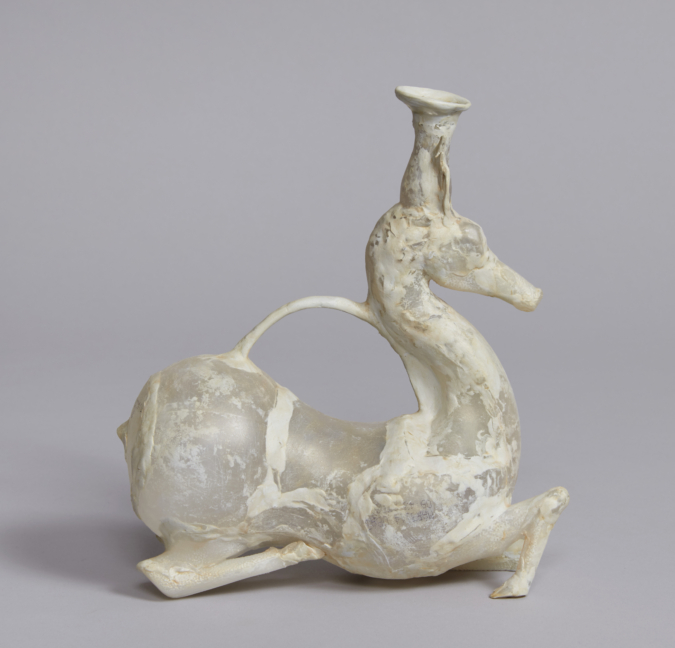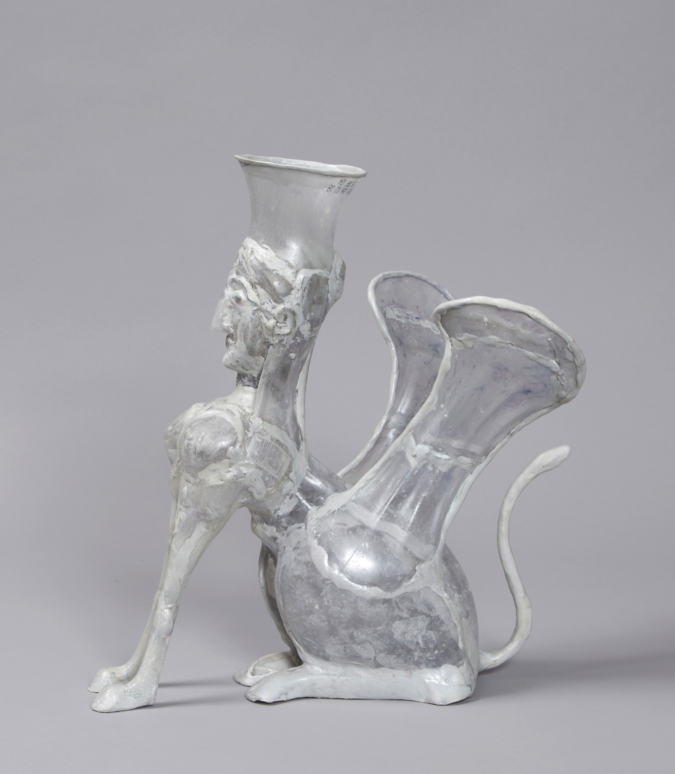Shari Mendelson
Shari Mendelson is a sculptor who lives and works in Brooklyn and upstate NY. She makes work that is inspired by ancient art and is composed mainly of repurposed plastic. Mendelson has received a Guggenheim Fellowship, A Pollock-Krasner Foundation Grant, and 4 New York Foundation for the Arts Fellowships. Museum collections include The MFA Boston, The MFA Houston, and The RISD Museum. She holds a BFA from Arizona State University and an MFA from SUNY New Paltz. In the Spring of 2020, she will be in a group show at the Arthur Ross Gallery at U Penn and have a solo show at Tibor de Nagy Gallery.
QUESTION:
The vessel, across cultures and times, thrives on simile. The vessel is like a body, a human body, a horse’s body, a camel’s body. The vessel’s handle is like a snake. The vessel’s spout is like a mouth. The comparison of beings to vessels appears to be inexhaustible and more prevalent with vessels than with other objects. Comparison is also pervasive in your work. Your work is like ancient vessels. The surface of the recycled plastic looks like glass. The ability to discover or make likeness seems very human and a great source for invention, yet, at the same time, the drive to compare as a tool of evaluation can stifle expression just as easily. What role does finding and forming likenesses play in your work?
ANSWER:
Thanks for this beautifully framed question. I like it.

Mythical Figure with Earrings, 2018 13.5 x 4 x 7 inches. Repurposed plastic, hot glue, resin, acrylic, polymer, sheet metal, gold. Photo credit: Alan Wiener
While forming a likeness of an ancient object, I feel as if I’m in communion with that object, as if I am in direct conversation with it. I’m drawn to ancient art not only for the formal beauty of the objects, but for what these works tell us about the time in which they were made and the visceral connection I feel to the ancient makers. This connection inevitably leads me to emulate these objects. I’m not bound by the original form, but inspired by it. Some of my pieces do adhere very closely to an original, while others riff on a variety of forms and subjects. In the rare instance that I create a piece that looks just like the original, the end result is not as satisfying as when things go awry. The parts of cast-off plastic bottles are not nearly as forgiving or immediate as clay, or as fluid as molten glass, and, despite my careful looking, things go “wrong” — a handle becomes too large, a horse’s leg is too short, the arm of a figure is too long. I can fight these deviations and adhere closely to the model or I can embrace them and make a new form, which is like the original, yet different. Usually I embrace the new direction.

Deer Askos, 2018 8 x 7 x 3 inches. Repurposed plastic, hot glue, acrylic, polymer, resin, mica. Photo credit: Alan Wiener
The act of creating a likeness dates back to the earliest civilizations – drawing a likeness of an animal on a cave wall, creating a fertility figure in the likeness of a woman, or creating a vessel in the likeness of a deer. And the use of one material to look like another is equally common throughout the history of art – early glass vessels emulated stone, stone-paste vessels emulated porcelain, and ceramic forms emulated metal forms. I’m following in a long tradition of artists and makers by using a modern material that is abundant in our culture to emulate a more valuable or rare material. Plastic, our modern contribution to the world of materials, is not only a ubiquitous nuisance, it may also contribute to the death of our civilization. I want to transform a bit of this throwaway material from being a perpetual threat to our ecology, into something to be valued.

Sphinx with Bar Code, 2018 13 x 7.5 x 10 inches. Repurposed plastic, hot glue, resin, acrylic polymer, mica, paint. Photo credit: Alan Wiener
The act of making a contemporary sculpture based on an ancient glass or terra-cotta artifact involves very close looking, and while looking, I’m learning. I love spending time intensely studying these objects — understanding how different parts come together, noticing the elegance or awkwardness of a curve, admiring the surface color and texture, and internalizing the essential drawing and form that creates the character of the piece. I find these pieces intoxicating – they fill up my mental image bank and always give me a point of departure. For me, the idea of self-expression is deeply connected to my love of these things that I think about, care about, and know intimately. What else could I express?






I really appreciate & relate to your description of your interaction with your ancient sources. Especially the way your process requires you to find “substitutions” for forms, & thus propels creative solutions.